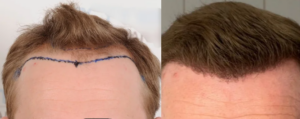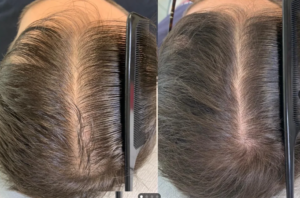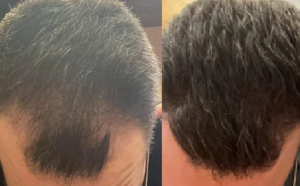Key PointsQuestion Is oral minoxidil effective in treating androgenetic alopecia in men compared with topical minoxidil, 5%?
Findings In this double-blind, placebo-controlled randomized clinical trial including 90 men with androgenetic alopecia, daily oral minoxidil, 5 mg, was well tolerated and did not demonstrate superiority over topical minoxidil, 5%, in men with androgenetic alopecia after 24 weeks of treatment.
Meaning Low-dose oral minoxidil (5 mg per day) had similar efficacy to topical minoxidil, 5%, for men with androgenetic alopecia and can be an option for patients who prefer oral therapy or are intolerant to topical treatment.
Importance There has been increased interest in low-dose oral minoxidil for androgenetic alopecia (AGA) treatment. However, the efficacy of oral minoxidil for male AGA is yet to be evaluated in comparative therapeutic trials.
Objective To compare the efficacy, safety, and tolerability of daily oral minoxidil, 5 mg, vs twice-daily topical minoxidil, 5%, for 24 weeks in the treatment of male AGA.
Design, Setting, and Participants This double-blind, placebo-controlled randomized clinical trial was conducted at a single specialized clinic in Brazil. Eligible men with AGA aged 18 to 55 years classified using the Norwood-Hamilton scale as 3V, 4V, or 5V were included and randomized. Data were collected from January to December 2021, and data were analyzed from September 2022 to February 2023.
Interventions Participants were randomized 1:1 into 2 groups: oral minoxidil, 5 mg, daily and topical placebo solution; or 1 mL of topical minoxidil, 5%, twice daily and oral placebo for 24 weeks.
Main Outcomes and Measures The primary outcome was change in terminal hair density on the frontal and vertex regions of the scalp. The secondary outcomes were change in total hair density and photographic evaluation.
Results Among 90 enrolled participants, 68 completed the study; of these, the mean (SD) age was 36.6 (7.8) years. A total of 33 participants were enrolled in the oral minoxidil group and 35 in the topical treatment group. Both groups were homogenous in terms of demographic data and AGA severity. For the frontal area, the mean change from baseline to week 24 between groups was 3.1 hairs per cm2 (95% CI, ?18.2 to 21.5; P?=?.27) for terminal hair density and 2.6 hairs per cm2 (95% CI, ?10.3 to 15.8; P?=?.32) for total hair density. For the vertex area, the mean change from baseline to week 24 was 23.4 hairs per cm2 (95% CI, ?0.3 to 43.0; P?=?.09) for terminal density and 5.5 hairs per cm2 (95% CI, ?12.5 to 23.5; P?=?.32) for total hair density. According to the photographic analysis, oral minoxidil was superior to topical minoxidil on the vertex (24%; 95% CI, 0 to 48; P?=?.04) but not on the frontal scalp (12%; 95% CI, ?12 to 36; P?=?.24). The most common adverse effects in the oral minoxidil group were hypertrichosis (22 of 45 [49%]) and headache (6 of 45 [14%]).
Conclusions and Relevance In this study, oral minoxidil, 5 mg, once per day for 24 weeks did not demonstrate superiority over topical minoxidil, 5%, twice per day in men with AGA.
Trial Registration Brazilian Registry of Clinical Trials Identifier: RBR-252w9r




